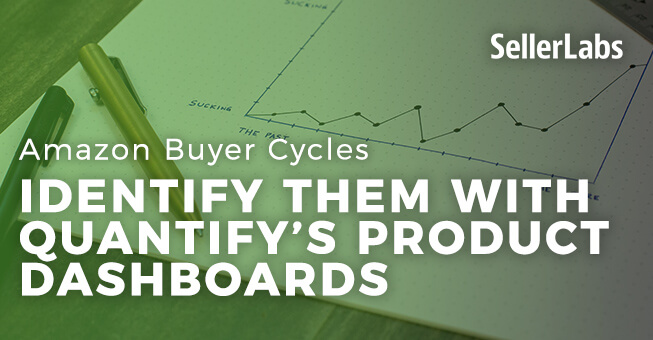Amazon Buyer Cycles: Identify Them with Quantify’s Product Dashboards

“Customer insights.” “Buyer’s journey.” “Buying cycles.” The language of today’s brand marketers and e-commerce gurus has shifted squarely to the data we can glean from online shoppers.
And with more data available about buyers than ever before, it’s exciting to imagine taking advantage of all this information: how your buyers purchase, when they purchase, what they do leading up to a purchase, what else they purchase, among other data points. By knowing more about buyers—your buyers—you can make better decisions about what products you introduce to the market, and when and how you promote them.
But frankly, Amazon Seller Central just doesn’t give you much.
Fortunately, Quantify can help but I would venture that there’s more you need to know than what we currently give. So I want to talk through how we can help you get started—and then I need your opinions on what information we can help you uncover.
Visualize buying cycles with Amazon purchase data.
What is the buying cycle? Summarized, it’s a pattern of buying that could take place over the course of a week, a month, or months. If you sell very seasonal products, you may see a buying cycle take place over the course of a year.
Since Quantify gives you much more data than Seller Central (up to two years’ worth), you can view the sales over time as well as graphs to see when your peak purchases are. For any product, view the Sales over time graph on the Overview tab.
Are there cycles to your peaks and valleys? Over weeks, months, quarters, or the year? If you see a clear pattern, that shows you a cycle. If you don’t, expand the timeframe you’re looking at.
Look at the peaks: do they correspond to any other activities? Seasons, dates or holidays, or ad campaigns you’ve run?
Discover the rest of the buying cycle by comparing traffic to conversion.
It’s possible that your customers’ buying behavior doesn’t—or is yet to—tell you a story about what they are doing. But what’s very important about a buying cycle is that it’s not only the buying behavior—it’s also the shopping behavior that is important. And Quantify can help you there, too.
For any product, you can dive into the Performance tab, and take a peek at the Sessions dashboard. This graph reveals the traffic your product has seen, which is related to shopping behavior, whether it leads to purchase or not. This can be very revealing. For example:
Do you see a period where sessions are high but conversion is low? Buyers are shopping but may not be buying…yet. Planning promotions at high traffic time could help.
Do you see a period where sessions are low but conversions are high? Is this expected like with seasonality, for example? If it isn’t, it may be time to review your listings and the latest relevant keyword data to get more traffic to your product listings.
But, there’s more to buyer behavior than the cycle.
For example, something with more information about the search terms can lead to a purchase.
This currently isn’t a feature within Quantify, but we’ve got it in Scope. For tracked products, you can view the estimated sales for any tracked keywords. For more information on using this feature, check out this month’s Scope blog.
Now I’m interested in your ideas and thoughts. What information do you lack—but seek—to run your business better? What other data points do you examine in your decision-making process?
I’m interested in learning from you. Reach out to Customer Success to contact me about your ideas about how we can get you better information for your Amazon business and buyers.

Jeff has more than 15 years of eCommerce experience. He is the Principal Evangelist of Advertising API at Amazon and a frequent keynote speaker at various business related conferences. He's widely regarded as an industry expert who is asked to share actionable intelligence on how Amazon works and how sellers can improve their business.






